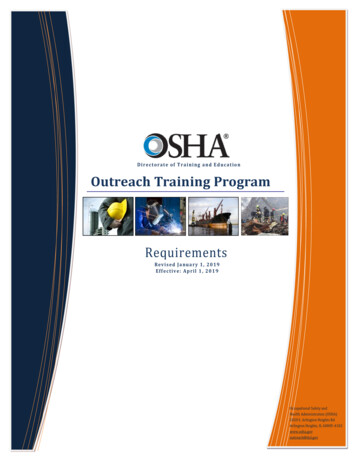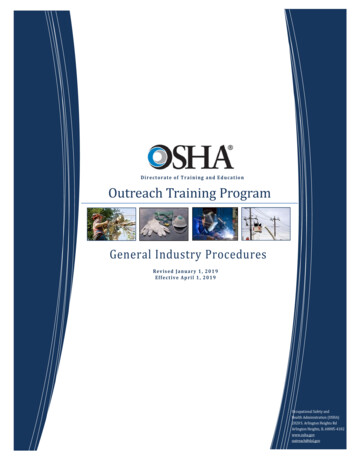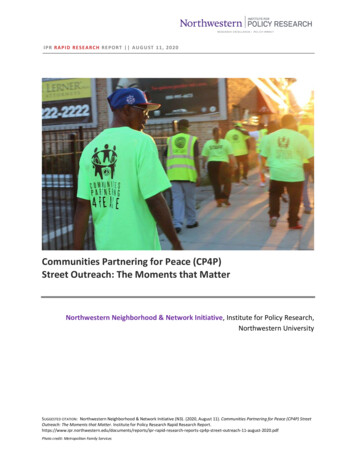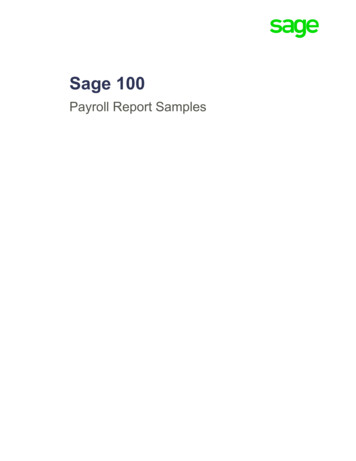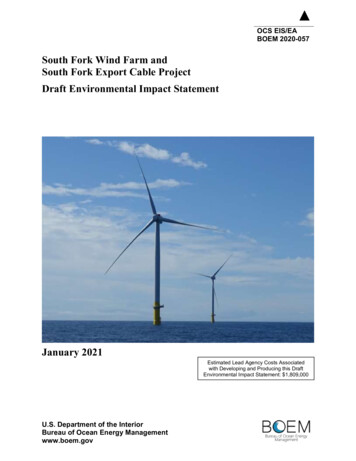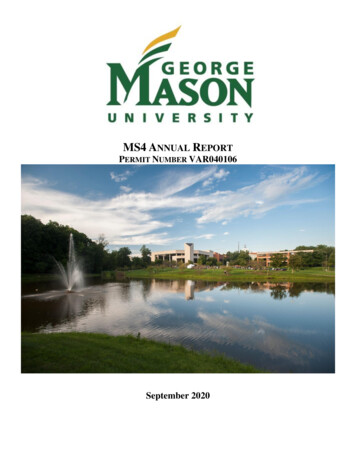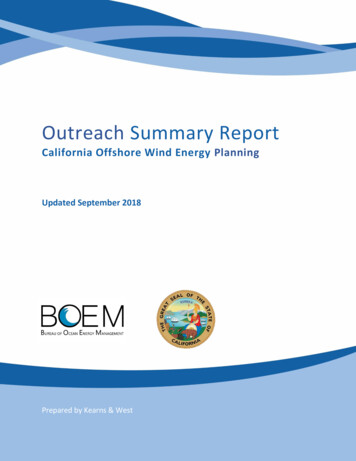
Transcription
Outreach Summary ReportCalifornia Offshore Wind Energy PlanningUpdated September 2018Prepared by Kearns & West
Table of ContentsExecutive Summary . 31. Overview . 52. Coastal Communities . 113. Fishing Communities . 164. Tribal Outreach and Engagement . 195. Data/Science Outreach . 206. Next Steps . 227. Appendices . 23Outreach Summary Report: California Offshore Wind Energy Planning2 Page
Executive SummaryIn 2016, at the request of California Governor Edmund G. Brown, the Bureau of Ocean EnergyManagement (BOEM) established the BOEM California Intergovernmental Renewable Energy TaskForce (California Task Force or Task Force). The Task Force includes members from federal, state,and local agencies, as well as federally-recognized tribes and provides critical information to theassessment of potential renewable energy development offshore California and to BOEM’sdecision-making process for leasing areas of the outer continental shelf and permitting offshorerenewable energy projects. The Task Force also serves as a forum to discuss stakeholder issues andconcerns; exchange data and information about biological and physical resources, ocean uses andpriorities; and facilitate early and continual dialogue and collaboration opportunities.At the Task Force’s first meeting in October 2016, members affirmed that collaborative datagathering and outreach effort with local tribes, coastal communities, and other stakeholders wouldprovide useful information for future California Task Force discussions. Subsequently, BOEM andthe State worked with a group of Task Force members to identify outreach goals, target audiences,and activities to inform the creation of a Stakeholder Outreach Plan. The data gathering andoutreach/engagement efforts shown in the Stakeholder Outreach Plan were designed to supportBOEM’s federal leasing process and the potential issuance of a “Call for Information andNominations for Commercial Leasing for Wind Power Offshore California” in the Federal Register.Between February 2017 and September 2018, BOEM and the State held 12 meetings withCalifornia tribes and 67 meetings with elected officials, commercial fishing community, mariners,academics and environmental groups, and the public. These meetings took place in Arcata,Crescent City, Eureka, Los Angeles, Morro Bay, Port San Luis, Oxnard, Sacramento, San Clemente,San Francisco, San Luis Obispo, and Santa Barbara. Table ES.1 provides a summary of thesemeetings.Table ES.1 Summary of outreach and engagement meetings to support BOEM CA offshore windenergy planning.ParticipantsNumber ofmeetingsPublic meetings/webinarsFishing communityElected officialsAcademicsTribesEnvironmental groupsMaritime community6182631254Outreach Summary Report: California Offshore Wind Energy Planning3 Page
Science/Data Core GroupTotal:579Key input and concerns received from public, tribal, and stakeholder engagement meetings arelisted in the box and discussed in later sections. Stakeholders from a variety of sectors have a high level of interest in discussing thepossible role and need for offshore wind in California’s energy portfolio;There is a high level of concern from commercial fishing stakeholders about potentialimpacts to their current activities and long-term livelihoodParticipants from multiple sectors have concerns about potential environmental, visual,and noise impacts from offshore wind facilities;Many stakeholders expressed interest about potential impacts to existing maritimeactivities and routes, including potential impacts to Department of Defense activities;Elected officials and coastal community members were interested in both positive andnegative economic impacts associated with development of offshore wind facilities; andMost stakeholders were unfamiliar with floating offshore wind technologies and wantedadditional educational opportunities and information about their operation, use in otherlocations, potential impacts, and decommissioning.Outreach Summary Report: California Offshore Wind Energy Planning4 Page
1.Overview1.1 BackgroundCalifornia has a long history of strong leadership and ambitious initiatives to fight climate changeand advance renewable energy and alternative, clean fuel policies. In 2018, California passedlegislation advancing the state’s existing Renewables Portfolio Standard (RPS), which requires aspecified percentage of the state’s electricity to come from renewable energy resources, to 50percent by 2025 and 60 percent by 2030, and established a 100 percent clean electricity goal forthe state by December 31, 2045 1. Governor Brown also issued Executive Order B-55-18 inSeptember 2018, establishing a new target to achieve carbon neutrality by 2045.The Bureau of Ocean Energy Management (BOEM), with jurisdiction to authorize renewableenergy projects on the Outer Continental Shelf (OCS), received the first formal notice of interest inrenewable energy development offshore California in January 2016. In a May 12, 2016 letter tothen-Department of Interior Secretary Sally Jewell, California Governor Edmund G. Brownrequested formation of a federal-state government task force to facilitate coordination, planningand permitting of state and federal activities related to offshore renewable energy. In response,BOEM established the BOEM California Intergovernmental Renewable Energy Task Force (CaliforniaTask Force or Task Force) as a partnership of state, local, and federal agencies, and federallyrecognized tribal governments. This Task Force provides critical information to the assessment ofpotential offshore renewable energy development offshore California and BOEM’s decisionmaking process to lease areas of the outer continental shelf for offshore renewable energydevelopment. It also serves as a forum to discuss stakeholder issues and concerns; exchange dataand information about biological and physical resources, ocean uses and priorities; and facilitateearly and continual dialogue and collaboration opportunities.1.2 Data GatheringBOEM and California held their first Task Force meeting in October 2016 to determine how themembers could best collaborate to assess the potential for offshore wind development and toinform BOEM’s decision-making process for identifying potential areas for offshore renewableenergy development. Task Force members affirmed that collaborative data gathering and outreachefforts with tribes, coastal communities and other stakeholders would provide useful information forfuture discussions on potential offshore wind energy areas. Task Force members also identified aneed for tribal outreach to include non-federally recognized tribes. To address this concern, theState formed the State Tribal Ocean Renewable Energy Working Group to gain input from bothfederally recognized and non-federally recognized tribal governments. California Task Forcemembers also agreed that creating a California Offshore Wind Energy Gateway1Chapter 312, Statutes of 2018 (SB 100, De Leon).Outreach Summary Report: California Offshore Wind Energy Planning5 Page
(https://caoffshorewind.databasin.org/) housing spatial datasets pertinent to offshore wind energyplanning for California would help inform the public, stakeholders, California Task Force memberson data used in the decision-making process and assist BOEM in identifying appropriate areas foroffshore wind energy development.2 BOEM and the State are pursuing a data and informationgathering effort along the entire California coast focused on ecological and natural resources,coastal and marine management, fishing community, community values and traditional uses, andenergy and physical setting.1.3 Outreach and Engagement Planning and ActivitiesBOEM with other federal and state agencies identified outreach goals, target audiences, andactivities in a stakeholder outreach plan. The plan focused outreach on the individuals and groupsmost likely to have sources of relevant data and affected by or have an interest in potential futureoffshore wind energy projects.Between February 2017 and September 2018 BOEM and the State held meetings, webinars, andbriefings with members of coastal communities, fishing communities, Native American tribes,local, state, and federal agencies, academics and scientists, environmental NGOs, and renewableenergy developers. The timeline of meetings and the numbers and types of participants for eachmeeting are in Figures 1.1 through 1.4 below. Additional details on the engagement meetings arein Appendix 3.The State of California took the lead on providing information to, and gathering initial input from,both federally recognized and non-federally recognized tribes in California. A summary of theoutreach to Native American tribes, led by the State of California and including BOEM staff, isincluded in Section 4 (below) and in Appendix 4 of this report.2Data Basin is an online, data sharing and mapping platform that allows state and federal agencies, interestedstakeholders, and the public full access and use of data and information for problem solving, which in this case focuseson offshore wind energy planning in California.Outreach Summary Report: California Offshore Wind Energy Planning6 Page
Figure 1.1: BOEM CA Offshore Wind Energy Planning Outreach Meeting Timeline: October 2016 July2017Figure 1.2: BOEM CA Offshore Wind Energy Planning Outreach Meeting Timeline: August 2017 –September 2018Outreach Summary Report: California Offshore Wind Energy Planning7 Page
Figure 1.3: BOEM CA Offshore Wind Energy Planning Outreach Stakeholder Meetings: October 2016– September 201890Number of (5)DataMaritime Total # ofScience (5) Community Meetings(4)(79)Meeting CategoryFigure 1.4: BOEM CA Offshore Wind Energy Planning Outreach Stakeholder Participation: October2016 –September 02612ElectedOfficials26 MTGSAcademics3 MTGS10253420Public6 MTGSFishingCommunity18 MTGSTribal12 MTGSData Science Maritime5 MTGSCommunity4 MTGSNGOs5 MTGSTotalStakeholderParticipationMeeting CategoryOutreach Summary Report: California Offshore Wind Energy Planning8 Page
1.4 Outreach and Engagement ResultsOutreach and engagement activities allowed BOEM and the State to share information on theCalifornia Task Force; the potential for offshore wind in California; data gathering efforts; BOEM’soffshore wind leasing process and environmental reviews; state regulatory reviews; and to receivevaluable feedback.In terms of data gathering, the inquiries resulted in a significant number of referrals to other dataproviders and scientific experts in the realms of marine mammals, seabirds, and physical settings,as well as a large number of recommended datasets. The California Offshore Wind Energy Gateway(as of this writing) contains over 660 datasets3 representing information offshore California. BOEMand the State continue to work with data scientists to ensure we have the most recent and validdata and to present the large quantity of information in the most useful fashion to informdecision-making and provide transparency to the public.The outreach efforts prompted a variety of questions, concerns, and recommendations regardingdeveloping offshore wind for California.4 Primarily, stakeholders had concerns about potentialconflicts with existing ocean uses (commercial fishing, shipping, environmental and culturalresources, etc.) and sought additional information about the mix of California’s energy portfolio,how floating offshore wind facilities operate, how BOEM’s offshore wind leasing and approvalprocess works, and who makes decisions and has regulatory oversight of offshore wind facilities.BOEM and the State are continuing to solicit information and concerns about conflicts with existinguses to inform future offshore wind energy planning decisions.Key input and concerns relayed during the outreach effort included A high level of interest in the possible role and need for offshore wind in California’s energyportfolio across all stakeholder groups;Potential short-term and long-term impacts to the commercial fishing industry, currentfishing activities, and livelihood;Impacts to cultural landscapes and areas of spiritual significance;Unknown and potential impacts to species, endangered species, breeding grounds, andhabitats from construction and/or operational activities’Compatibility with and impacts to military training, testing and operational activitiesoffshore California;Positive and negative economic impacts (jobs, tourism, redevelopment of local assets)associated with development of offshore wind facilities;Impacts to views from beaches, hills along coastline;Unknown and potential noise impacts on shore and on species from operational offshorewind facilities;3The California Offshore Wind Energy Gateway contains some repetitive data sets. Additionally, not all data has beenpeer-reviewed and/or published in scientific journals.4Initial input from Native American tribes in California are in Appendix 4.Outreach Summary Report: California Offshore Wind Energy Planning9 Page
Potential impacts to existing maritime activities and routes;Operational durability of offshore facilities during ocean storms, specifically NorthernCalifornia;Source of carbon-free energy that would help state combat climate change, replace localnon-carbon-free generation sources, and strengthen local energy resiliency.General unfamiliarity with floating offshore wind technologies and desire for additionaleducational opportunities and information about their operation, experiences in otherlocations, potential impacts, and decommissioning.1.5 Next StepsTogether, the data gathering and outreach efforts are designed to support a potential decision byBOEM to issue a “Call for Information and Nominations for Commercial Leasing for Wind PowerOffshore California” (in accordance with the Department of Interior/California Memorandum ofUnderstanding)5 in the Federal Register.This report summarizes the key themes gathered through this engagement process.5Department of Interior/State of California Memorandum of les/uploads/mou - doi and state of calif on renewable energy.pdfOutreach Summary Report: California Offshore Wind Energy Planning10 P a g e
2.Coastal CommunitiesBOEM and the State focused outreach (including local government officials, members of thepublic, environmental NGOs, and other stakeholders who live and work in coastal areas and wouldbe impacted by offshore wind energy development)6 on the North and Central Coast regions ofCalifornia. The outreach effort initially focused on the Central Coast because of the commercialinterest in that area, strong wind resources, and readily available existing transmissioninfrastructure. In late 2017, potential interest began in the North Coast area and in February 2018,the Redwood Coast Energy Authority issued a Request for Qualifications for a public-privatepartnership to pursue an offshore wind energy project off Humboldt County. Subsequently,outreach activities expanded to include the North Coast.BOEM and the State participated in 79 meetings and briefings with various interested groups,including the public, tribes, governmental officials, mariners, and environmental groups in Arcata,Crescent City, Eureka, Los Angeles, Morro Bay, Oxnard, Port San Luis, Sacramento, San Clemente,San Francisco, San Luis Obispo, and Santa Barbara between February 2017 and September 2018.Appendix 3 describes the types of meetings and the participants at meetings.The following five subsections describe the majority of the feedback received.2.1 Potential Conflicts with Existing Ocean UsesLocal elected officials, members of the public, and environmental groups shared concerns aboutoffshore wind development having potential visual and noise impacts, potential impacts to thecommercial fishing sector and to tourism, and interactions with nearby Marine Protected Areas(MPAs). Concerns also include potential conflicts with existing vessel traffic, aviation traffic andmilitary training, testing, and operations off the California coast, specifically U.S. Air Force missionsout of Vandenberg Air Force Base and U.S. Navy access to the ocean and space above it. Electedofficials also inquired about economic impacts, both positive and negative, from offshore winddevelopments.Some Central Coast community members inquired about the compatibility of offshore winddevelopment with the proposed Chumash Heritage National Marine Sanctuary.7 EnvironmentalNGOs inquired about tradeoffs between offshore wind developments near Santa Barbara asopposed to San Luis Obispo. Additionally, environmental NGOs had numerous questions aboutpotential effects of offshore wind on the environment, such as impacts of construction andoperation noise on marine mammals and fish, and impacts to bird migration.6Outreach to fishing communities is in section 3.The area of proposed protection is located between the Channel Islands National Marine Sanctuary and the Monterey BayNational Marine Sanctuary and out to the western slope of the Santa Lucia Bank.7Outreach Summary Report: California Offshore Wind Energy Planning11 P a g e
2.2 California’s Energy PortfolioParticipants in outreach meetings were curious about the State’s energy portfolio and the potentialrole of offshore wind. These questions focused on whether offshore wind would be a cost-effectivechoice for ratepayers, who would pay if it were more expensive than other energy resources, andwhether California should support a new technology such as floating offshore wind.Some participants wondered whether onshore wind would provide an equivalent or even superiorrenewable energy resource for California, or whether wave energy would be a better choice. Localgovernment entities inquired if leasing for offshore wind would generate revenues for the State orlocal governments. Lastly, coastal community members questioned whether the existingtransmission infrastructure is sufficient to support the addition of offshore wind energy.BOEM and the State provided information to stakeholders about the State’s energy policies, powermix, and the review process for energy projects in California. Specifically, the State emphasizedthat it is implementing one of the most comprehensive and aggressive greenhouse gas emissionreduction agendas in the world and has ambitious renewable energy goals. The “California GlobalWarming Solutions Act of 2006” requires the state to reduce greenhouse gas emissions to 1990levels by 2020. Subsequent legislation created additional greenhouse gas emissions reductiontargets: 40% below 1990 levels by 2030, and a further reduction to 80% below 1990 levels by2050. Additionally, recent legislation in California (SB 100) requires that 60% of electricity sales besourced from renewable energy by 2030 and sets a goal for 100% of electricity in California to becarbon-free by 2045. The state has commented that while offshore wind generation has greatpotential to help the state to meet its renewable energy and climate goals, any development musttake into consideration the potential impacts to the state’s coastline and ocean.2.3 Floating Offshore Wind TechnologiesMany of the meeting participants were unfamiliar with floating offshore wind technologies andasked about their use and testing to date, lessons learned from other installations, compatibilitywith other ocean uses, the European experience with offshore wind energy, risks to theenvironment, installation procedures and potential for co-location on existing oil platforms.Furthermore, some stakeholders mentioned concerns about electromagnetic interference fromsubmarine cables on marine mammals and sharks in the area. A number of participants expressedinterest in ensuring that decommissioning of these facilities would occur after use.Overall, a number of the participants were curious about the technologies and felt the technologyhad potential to be an appropriate carbon -free energy source for California if sited and constructedcarefully.Outreach Summary Report: California Offshore Wind Energy Planning12 P a g e
BOEM and the State provided information to stakeholders about the offshore wind industry andprovided technology illustrations such as the one in Figure 2.1 below. The California EnergyCommission also discussed their Memorandums of Agreement with Denmark and Scotland toshare knowledge, experiences, best practices, and data relevant to the development of offshorewind facilities.8Figure 2.1: Informational Graphic on How Offshore Floating Wind Farms Work2.4 Decision-Making Process and TimelineCoastal communities voiced considerable interest in being able to participate in decisions related tooffshore wind energy development and in the planning and development process. Stakeholdersinquired about opportunities in the process for the public to provide formal comments.Additionally, stakeholders inquired about California Task Force membership and its process forinforming BOEM’s decisions on offshore wind energy leasing and development. (The attendancelist from the October 2016 meeting is available at -TF/.) Some asked about whether the current federal administration is continuing tosupport offshore renewable energy development.Lastly, environmental NGOs inquired about the decision-making process for the types and qualityof data that uploaded into the California Offshore Wind Energy Gateway (see Section 4 below forfurther mate action team/intergovernmental/MOU-Denmark CEC mate action team/intergovernmental/MOUOffshore Wind between CEC and the Government of Scotland.pdfOutreach Summary Report: California Offshore Wind Energy Planning13 P a g e
2.5 Regulatory JurisdictionStakeholders want to ensure future review of offshore wind development by all relevant state andfederal agencies. There was considerable interest in the role of state agencies in permitting, andwho are the lead federal and state agencies would be for the environmental review of a project.Several stakeholders inquired about which agencies would provide oversight of the facilities duringand after construction, to ensure safety.2.6 Maritime Sector EngagementThe U.S. Coast Guard, as subject matter expert for offshore navigation and safety, has coordinatedwith BOEM and the State of California on outreach to the maritime sector. The maritime sectorincludes commercial vessel operators, port authorities and personnel, and Harbor SafetyCommittees. Maritime outreach meetings are in Table 2.1 below. Maritime stakeholdersexpressed interest in offshore wind technologies and the surface and subsurface area that couldbe occupied by projects, types of mooring/anchoring systems, and any requirements and/orrestrictions within project boundaries that may be implemented by the U.S. Coast Guard (i.e.,would vessels be allowed to transit between turbines, types of structural lighting, etc.).BOEM’s regulations require lessees provide a Navigational Safety Risk Assessment (NSRA) for aproject. The U.S. Coast Guard reviews the NSRA. The U.S. Coast Guard District 11 participates onthe California Task Force.Table 2.1: Summary of Outreach Conducted with Maritime StakeholdersMeetingMeeting LocationDate1.Maritime OutreachMeeting8/1/2017Meeting with Los Angeles/LongBeach Harbor Safety Committee,Safety Subcommittee2.Maritime OutreachMeeting9/6/2017Meeting with representatives of thePort of Hueneme3.Maritime OutreachMeeting10/4/2017Meeting with Los Angeles/LongBeach Harbor Safety Committee(full committee)4.Maritime OutreachMeeting11/9/2017Meeting with San Francisco BayHarbor Safety CommitteeOutreach Summary Report: California Offshore Wind Energy PlanningParticipants14 P a g e
2.7 U.S. Department of Defense EngagementBOEM and the State have coordinated closely with the U.S. Department of Defense throughoutthe offshore wind planning process and they are active members of the California Task Force. TheOffice of the Secretary of Defense and representatives from the U.S. Marine Corps, U.S. Navy, andthe U.S. Air Force participated in the Task Force meetings and were active participants in offshorewind outreach and engagement meetings in 2017 and 2018. Additional staff participated inworkshops held by the California Energy Commission, and provided briefings and participated inmeetings with BOEM and the State.The Department of Defense issued an initial Mission Compatibility Assessment in 2017 evaluatingthe compatibility of offshore wind turbines with current and proposed military uses off California9.That Assessment showed that offshore wind development along the Central California wouldconflict with military testing, training and operations and compatibility conflicts could likely bemanaged on the north coast. The Department of Defense is also continuing to meet withdevelopers, review more detailed project and operation plans, and determine if there are anyactions to improve the feasibility of siting offshore wind power along the Central Coast. BOEM willconsider this information and input in BOEM’s offshore wind planning and leasing les/2017/08/DON-Composite CA-Offshore 8-JUN-2017-1.pdf 9Outreach Summary Report: California Offshore Wind Energy Planning15 P a g e
3.Fishing CommunitiesBOEM and the State participated in 18 meetings and briefings with fishermen and fishing relatedorganizations between February 2017 and September 2018. Table 3.1 below lists these meetings.BOEM and the State focused their engagement on fishing communities in Crescent City, Eureka,Morro Bay, Port San Luis, Sacramento, Santa Barbara, and San Clemente.Table 3.1: Summary of Outreach Meetings with Fishing Community StakeholdersNo.Meeting LocationDateParticipants1.Morro Bay2/21/17Morro Bay Commercial Fishermen’s Organization,Morro Bay Harbor District, Central Coast CableCommittee2.Port San Luis2/22/17Port San Luis Harbor District, Port San Luis fishermen3.Santa Barbara3/15/17Commercial Fishermen of Santa Barbara4.San Clemente3/23/17California Fish and Game Commission MarineResources Committee5.Phone3/27/17Alliance for Sustainable Fisheries6.Sacramento3/28/17Pacific Coast Federation of Fishermen’s Associations7.Sacramento4/6/17Pacific Fisheries Management Council HabitatCommittee8.Sacramento4/7/17Pacific Fisheries Management Council GroundfishAdvisory Panel9.Santa Barbara4/12/17Southern California Trawlers’ Association10.Van Nuys4/27/17California Fish and Game Commission11.Morro Bay7/6/17Morro Bay Commercial Fishermen’s Organization12.Morro Bay7/6/17Morro Bay Harbor Advisory Board13.Port San Luis7/7/17Port San Luis Harbor District, Port San Luis fishermen14.Eureka4/19/18Humboldt Fishermen’s Marketing Association15.Seattle5/17/18United Catcher Boats, Phoenix Processor LimitedPartnership, Arctic Storm, Fury Group16.Crescent City7/17/18Crescent City fishermenOutreach Summary Report: California Offshore Wind Energy Planning16 P a g e
No.Meeting LocationDateParticipants17.Crescent City7/17/18Crescent City Harbor District18.Eureka7/18/18Humboldt Fishermen’s Marketing Association3.1 Potential Conflicts with the Commercial Fishing IndustryCommercial fishing stakeholders consistently expressed concerns about potential loss of fishinggrounds and entanglement of gear and voiced a desire for siting of wind energy projects in areasalready closed off to or less used by fishing stakeholders. Some recommended consideration ofother California coastal areas for offshore wind energy e.g., Bodega Bay, Crescent City, Santa Cruz.Concerns included: Will the U.S. Coast Guard prohibit vessel entry through wind facility areas;Impacts on marine species from construction and operation activities;Wind turbines and associated mooring and anchoring facilities may result in safety risks tofishermen and their equipment;Transmission cables and anchoring systems may be snagged by fishing gear;rerouting of container ships to avoid facilities could cause displacement for fishing vessels;Facility infrastructure that is not fully decommissioned could result in ocean use conflicts;Physical stability of floating turbine structures, including ability to withstand high winds off thenorthern part of the State;Potential impacts to fishing operations due to construction staging activities; andCumulative effects of loss of fishing grounds from National Marine Sanctuaries, State MarineProtected Areas, and other exclusion areas.Commercial fishing stakeholders expressed a desire for compensation for both lost fishing groundsand time participating in public processes around offshore wind planning. They also expressedinterest in learning how jurisdictions that have deployed offshore wind generating facilitiesmitigated impacts to fishing communities. Some suggested that a method of compensating for lostfishing grounds could be re-opening areas currently closed to fishing, in proportion to future areasthat would be closed to fishing. Many felt that the existin
Outreach Summary Report: California Offshore Wind Energy Planning 4 P a g e Science/Data Core Group 5 Total: 79 Key input and concerns received from public, tribal, and stakeholder engagement meetin

